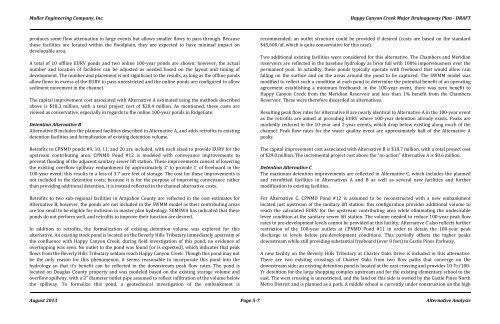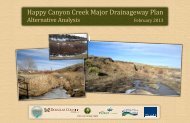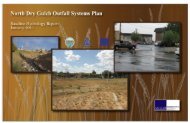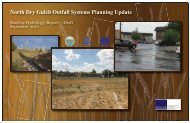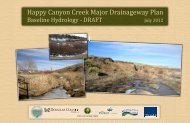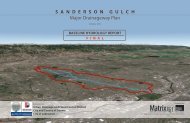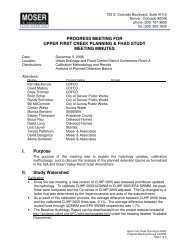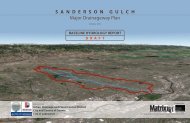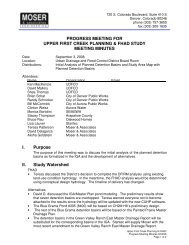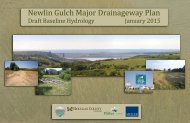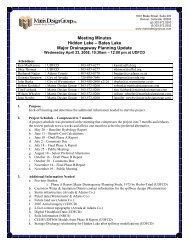PDF (53.8 MB) - Urban Drainage and Flood Control District
PDF (53.8 MB) - Urban Drainage and Flood Control District
PDF (53.8 MB) - Urban Drainage and Flood Control District
You also want an ePaper? Increase the reach of your titles
YUMPU automatically turns print PDFs into web optimized ePapers that Google loves.
Muller Engineering Company, Inc.<br />
Happy Canyon Creek Major <strong>Drainage</strong>way Plan - DRAFT<br />
produces some flow attenuation in large events but allows smaller flows to pass through. Because<br />
these facilities are located within the floodplain, they are expected to have minimal impact on<br />
developable area.<br />
A total of 10 offline EURV ponds <strong>and</strong> two online 100-year ponds are shown; however, the actual<br />
number <strong>and</strong> location of facilities can be adjusted as needed based on the layout <strong>and</strong> timing of<br />
development. The number <strong>and</strong> placement is not significant to the results, as long as the offline ponds<br />
allow flows in excess of the EURV to pass unrestricted <strong>and</strong> the online ponds are configured to allow<br />
sediment movement in the channel.<br />
The capital improvement cost associated with Alternative A estimated using the methods described<br />
above is $18.3 million, with a total project cost of $28.4 million. As mentioned, these costs are<br />
viewed as conservative, especially in regards to the online 100-year ponds in RidgeGate.<br />
Detention Alternative B<br />
Alternative B includes the planned facilities described in Alternative A, <strong>and</strong> adds retrofits to existing<br />
detention facilities <strong>and</strong> formalization of existing detention volume.<br />
Retrofits to CPNMD ponds #9, 10, 11, <strong>and</strong> 20 are included, with each sized to provide EURV for the<br />
upstream contributing area. CPNMD Pond #12 is modeled with conveyance improvements to<br />
prevent flooding of the adjacent sanitary sewer lift station. These improvements consist of lowering<br />
the existing overflow spillway embankment by approximately 2’ to provide 1’ of freeboard in the<br />
100-year event; this results in a loss of 3.7 acre feet of storage. The cost for these improvements is<br />
not included in the detention costs; because it is for the purpose of improving conveyance rather<br />
than providing additional detention, it is instead reflected in the channel alternative costs.<br />
Retrofits to two sub-regional facilities in Arapahoe County are reflected in the cost estimates for<br />
Alternative B, however, the ponds are not included in the SWMM model as their contributing areas<br />
are too small to be eligible for inclusion in master plan hydrology. SEMSWA has indicated that these<br />
ponds do not perform well, <strong>and</strong> retrofits to improve their function are desired.<br />
In addition to retrofits, the formalization of existing detention volume was explored for this<br />
alternative. An existing stock pond is located on the Beverly Hills Tributary immediately upstream of<br />
the confluence with Happy Canyon Creek; during field investigation of this pond, no evidence of<br />
overtopping was seen. No outlet to the pond was found (or is expected), which indicates that peak<br />
flows from the Beverly Hills Tributary seldom reach Happy Canyon Creek. Though this pond may not<br />
be the only reason for this phenomenon, it seems reasonable to incorporate this pond into the<br />
hydrology so that it’s benefit can be reflected in the downstream peak flow rates. The pond is<br />
located on Douglas County property <strong>and</strong> was modeled based on the existing storage volume <strong>and</strong><br />
overflow spillway, with a 2” diameter outlet pipe assumed to reflect infiltration of the volume below<br />
the spillway. To formalize this pond, a geotechnical investigation of the embankment is<br />
recommended; an outlet structure could be provided if desired (costs are based on the st<strong>and</strong>ard<br />
$45,600/af, which is quite conservative for this case).<br />
Two additional existing facilities were considered for this alternative. The Chambers <strong>and</strong> Meridian<br />
reservoirs are reflected in the baseline hydrology as brim full with 100% imperviousness over the<br />
permanent pool. In actuality, these ponds typically operate with freeboard that would allow rain<br />
falling on the surface <strong>and</strong> on the areas around the pond to be captured. The SWMM model was<br />
modified to reflect such a condition at each pond to determine the potential benefit of an operating<br />
agreement establishing a minimum freeboard: in the 100-year event, there was zero benefit to<br />
Happy Canyon Creek from the Meridian Reservoir <strong>and</strong> less than 1% benefit from the Chambers<br />
Reservoir. These were therefore discarded as alternatives.<br />
Resulting peak flow rates for Alternative B are nearly identical to Alternative A in the 100-year event<br />
as the retrofits are aimed at providing EURV where 100-year detention already exists. Peaks are<br />
markedly reduced in the 10-year <strong>and</strong> 2-year events, which drop below existing along much of the<br />
channel. Peak flow rates for the water quality event are approximately half of the Alternative A<br />
peaks.<br />
The capital improvement cost associated with Alternative B is $18.7 million, with a total project cost<br />
of $29.0 million. The incremental project cost above the “no action” Alternative A is $0.6 million.<br />
Detention Alternative C<br />
The maximum detention improvements are reflected in Alternative C, which includes the planned<br />
<strong>and</strong> retrofitted facilities in Alternatives A <strong>and</strong> B as well as several new facilities <strong>and</strong> further<br />
modification to existing facilities.<br />
For Alternative C, CPNMD Pond #12 is assumed to be reconstructed with a new embankment<br />
located just upstream of the sanitary lift station; this configuration provides additional volume to<br />
reach the calculated EURV for the upstream contributing area while eliminating the undesirable<br />
levee condition at the sanitary sewer lift station. The volume needed to reduce 100-year peak flow<br />
rates to pre-development levels cannot be provided at this facility; Alternative C also reflects further<br />
restriction of the 100-year outlets at CPNMD Pond #11 in order to detain the 100-year peak<br />
discharge to levels below pre-development conditions. This partially offsets the higher peaks<br />
downstream while still providing substantial freeboard (over 8 feet) to Castle Pines Parkway.<br />
A new facility on the Beverly Hills Tributary at Charter Oaks Drive is included in this alternative.<br />
There are two existing crossings of Charter Oaks from two flow paths that converge on the<br />
downstream side; an existing detention pond is located at the east crossing <strong>and</strong> provides 10-Yr/100-<br />
Yr detention for the large shopping complex upstream <strong>and</strong> for the existing elementary school to the<br />
east. The west crossing is unrestricted, <strong>and</strong> the l<strong>and</strong> on this side is owned by the Castle Pines North<br />
Metro <strong>District</strong> <strong>and</strong> is planned as a park. A middle school is currently under construction on the high<br />
August 2013 Page 5-7 Alternative Analysis


